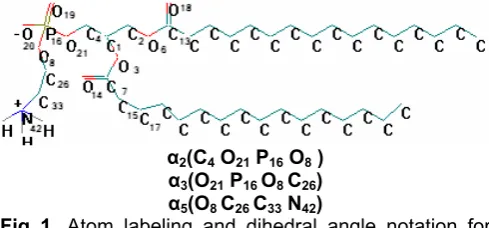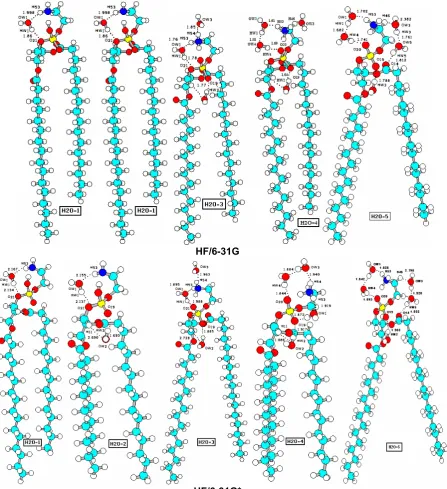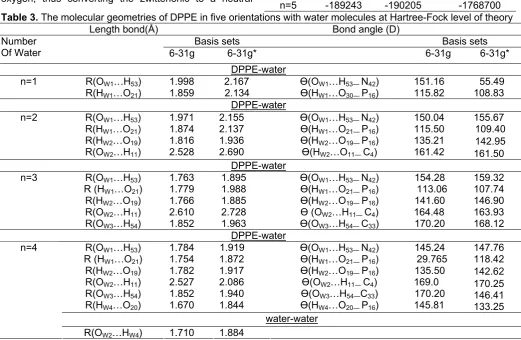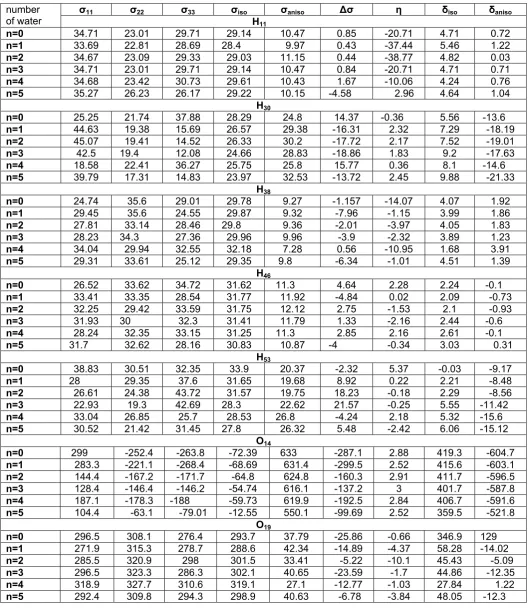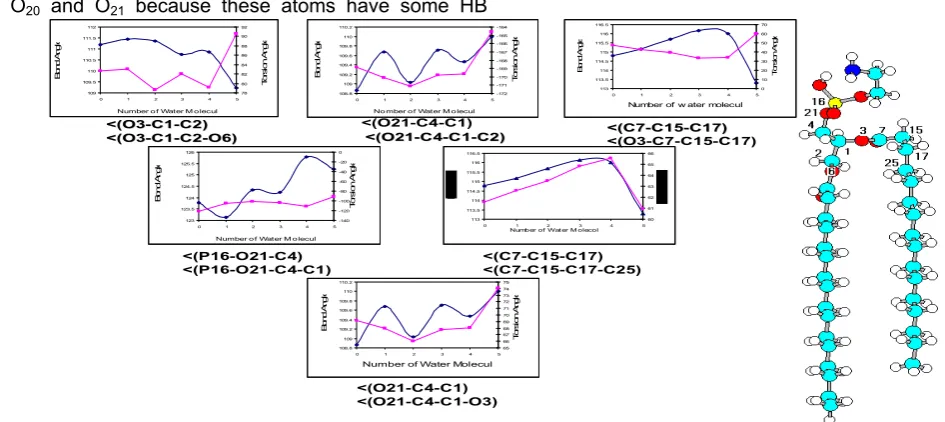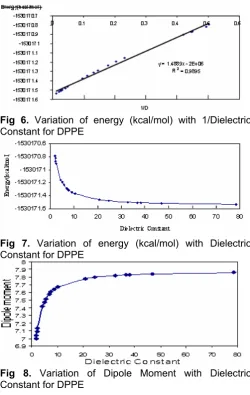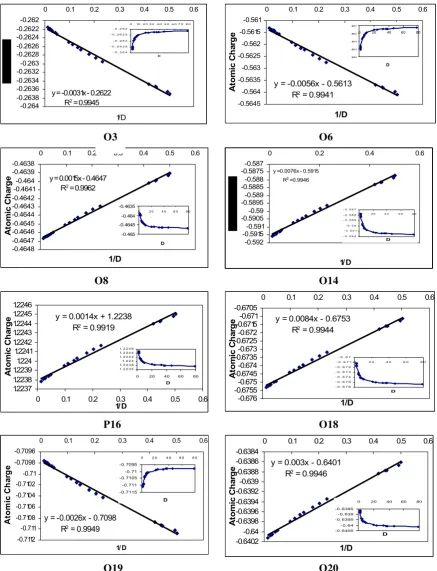QM AND AB
INITIO
INVESTIGATION ON THE HYDROGEN BONDING, NMR CHEMICAL
SHIFTS AND SOLVENT EFFECTS ON THE DPPE
M. Monajjemi1,*, A. Nouri2 , S. Afsharnezhad2, and H. Monajemi3
1
Department of Physical Chemistry, Science & Research Branch, Islamic Azad University, Tehran Iran
2.
Department of Biochemistry, Science & Research Branch, Islamic Azad University, Tehran Iran
2.
Department of Physics ,Karaj branch , Islamic Azad University, Iran
Received 17 May 2007; Accepted 18 September 2007
ABSTRACT
The hydrogen bonding effects that were produced from interaction of membrane lipid dipalmitoylphosphatidyl-ethanolamine (DPPE) with 1-5 water molecules, has been theoretically investigated through the quantum mechanical calculations at the Hartree-Fock level of theory and the 3-21G, 6-31G and 6-31G* basis sets with the computational package of Gaussian 98. According to the obtained results of the structural optimization of the isolated DPPE in the gas phase, we can see the evidences of interactions in the head group of this macromolecule (from the molecular point of view we have a proton transfer from the ammonium group to the phosphate oxygen of zwitterionic form. As we know that the hydrogen bonding of DPPE with water molecules which have surrounded its head group plays an important role in the permeability of DPPE. So, in order to understand the microscopic physico-chemical nature of this subject we have analyzed bond and torsion angles of DPPE before and after added water molecules. In this paper we have theoretically studied the complexes DPPE with water molecules which have surrounded its head group. As mentioned before, this theoretically study has been done through Hartree-Fock level of theory by using simple basis sets. Theoretical data shows that the interaction of head group of DPPE with water molecules causes some changes in the geometry of DPPE which were explained by the contribution of zwitterionic form of DPPE macromolecule, and finally hydrated DPPE becomes stable complex. Comparison between theoretical and experimental geometry data of DPPE macromolecule shows that the calculation at the HF/3-21 level of theory produces results which they are in better agreement with the experimental data. Moreover the hydrogen bonding effects on the NMR shielding tensor of selected atoms in the hydrated complexes of DPPE were reported. The “Gauge Including Atomic Orbitals” (GIAO) approaches within the SCF-Hartree-Fock approximation have been used in order to investigate the influence of hydrogen bonding of DPPE-water complex on the shielding tensors. Finally, the solvent affects on the stability of DPPE macromolecule, dipole moment and atomic charge of some selected atoms of DPPE molecule was discussed using Onsager model and Merz-Singh-Kolman schema.
Keywords : Gauge Including Atomic Orbital, DPPE,hydrogen bonding, solvation, quantum mechanics, ab initio
INTRODUCTION
It is obvious that biomembranes are composed of various types of lipids such as phospholipids, sphingolipids and glycolipids and these lipids are suggested to exist in different coexisting phases [1-3]. Phospholipids are the main constituents of the biological membranes that form the structural matrix which functional membrane such as proteins are imbedded [4]. Phospholipids are amphiphilic molecules with hydrophilic head groups of varying composition and two hydrocarbon tails. They assemble spontaneously in order to form bilayers that the hydrophobic tails pointed toward the center and head groups exposed to the aqueous phase [5]. The major phospholipids which are found in biological membranes are phosphatidylcholines (PCS) and phosphatidylethanolamine(PE) [1-3].
Phos-phatidylcholines and phosphatidylethanolamines are two lipids which they have a special place in the studies of scientists because both of them are present in large quantities in brain (neuronal) membranes. Furthermore,
they constitute a significant portion of the lipid environment of various neuropeptides and drugs [6]. Knowledge of the phase behavior of phospholipids helps us to understand the biofunctions of lipid assemblies in the living cells. It is clear that water is the most ubiquitous solvent on earth and it is an unusual liquid with a remarkably high dielectric constant and a low coordination number [7-9].
Now a day’s the study of nature and behavior of water at the surface of various biological membranes has a considerable situation among bioscientists. Science these biological surfaces contain phospho-lipids, the interaction of water molecules with these lipids is of particular relevance to the biological function of the membrane surface [10]. Water molecule has a crucial role in the supramolecular chemistry; it can stabilize complexes by acting as a hydrogen bonding bridge between components as demonstrated in many publications [11]. Hydrogen bonding plays an important role in the structure, function and dynamics of biological molecules. By computers and new
* Corresponding author.
Email address : m_monajjemi@yahoo.com
computational softwares structural geometry, energetic and dynamics of different types of molecular clusters have received much attention, since the information of such complexes could lead to the understanding of the interaction in the biological systems [12]. The hydrogen bond is normally characterized as a relatively weak interaction involving an electronegative proton donor X, a hydrogen, and an electronegative proton acceptor Y. The interaction is believed to be predominantly electrostatic in nature, although charge-transfer interactions are also important [7,13]. According to the classical electrostatic model of hydrogen bonding, the electron density of Y exerts an attractive force on the proton, and the approach of Y should always lengthen the X-H bond [7,13]. On the other hand, if significant charge transfer occurs from the proton acceptor Y to the proton donor, in particular to the X-H ó* antibonding orbital, the X-H bond should also be weakened based on the hydrogen bond formation and concomitantly elongated [7,13].On the other hand nuclear magnetic resonance (NMR) spectroscopy has grown as a powerful tool for chemical analysis, structure determination and the study of the dynamic of organic, inorganic and biological systems [12]. With respect to its versatility and applicability to molecular systems in all condensed phases, NMR spectroscopy is commonly used for studying hydrogen-bonding phenomena [14]. The recent advances in computer technology enable us to perform chemical shielding calculations of relatively large molecules or macromolecules by semi-empirical or ab initio molecular orbital frame works [15]. Chemical shift is one of the various physico-chemical parameters which is obtained by NMR techniques spectroscopy. This most accessible and useful quantity provides several information about molecular geometry as well as molecular electronic state [16]. Extensive studies show that NMR chemical shifts are quiet sensitive to the intermolecular interactions [14,17-19]. The hydrogen bonding effects on the isotropic chemical shift have been known, and understood in a qualitative manner for a long time [14,17-19]. Several studies have demonstrated the influence of intermolecular interactions on the chemical shielding tensors of 1H, 13C, and 15N nuclei [14,17-19]. However, relatively little is known about 17O chemical shielding tensors, in spite of the essential role of the oxygen-containing functional groups in organic and inorganic chemistry and biology. One of our goals in this paper is to investigate the hydrogen bonding of DPPE macromolecule’s shielding tensor.
For a long time and because of the gauge problem the computational of shielding tensors is difficult, as commonly used basis sets for quantum mechanical calculations do not guarantee the invariance of the results with respect to the chosen gauge. The first calculation methods, including the treatment of the gauge problem, appeared about 20 years ago [20]. In this work we made use of the ‘Gauge Including Atomic
Orbitals’ (GIAO) method [21-22], which has recently become a widely used technique leading to gauge-independent results [23-24].
THEORETICAL BACKGROUND
Chemical Shielding
The chemical shielding refers to the phenomenon which associated with the secondary magnetic field created by the induced motions of the electrons that surrounding the nuclei when in the presence of an applied magnetic field. The energy of a magnetic moment µ, in a magnetic field, B, is as follow: E = -μ . ( 1 – σ ) B (1) where the shielding σ, is the differential resonance shift due to the induced motion of the electrons. The chemical shielding is characterized by a real three-by-three Cartesian matrix, which can be decomposed into a single scalar term, three antisymmetric pseudo vector components, and five components corresponding to a symmetric tensor [25]. Only the single scalar and the five symmetric tensor elements can be observed in the normal NMR spectra of the solids. For brevity, these six values are usually referred to as the shielding tensor:
That can be obtained by averaging the off-diagonal values of the complete tensor [26].
The chemical shielding tensor is commonly referred to the chemical shift anisotropy (CSA) tensor according to the possession of second rank properties. The measurement or calculation of the diagonal components (σxx ,σyy ,σzz) or (σ11 ,σ22 ,σ33) in the principle axis system (PAS) allows the complete description of the CSA tensor [sandia].The CSA tensor can also be described by three additional parameters , a) The isotropic value (or trace portion of the CSA
tensor) σiso , of the shielding tensor which is defined as following expression :
Δσ = σ33 -
2
1
(σ11+σ22) (4)
and
c) The shielding tensor asymmetry parameter (η) which is given by:
Within the GIAO methodology, for calculation of magnetic properties, explicitly field-dependent wave functions are used, of the following form:
iso
σ
σ
σ
σ
η
−
−
=
33 11 22
(5)
)
0
(
)
(
2
exp
)
(
→ →
→ → →
⋅
⎥⎦
⎤
⎢⎣
⎡
−
×
⋅
=
μ μμ
χ
χ
B
R
r
c
i
B
(6)COMPUTATIONAL METHODS
where (
χ
μ being the field -dependent basis function,the position vector, denotes the (usual)
field-independent function, while c is the speed of light
in vacuum and
μ →
R
(
0
)
→ μ
χ
1
−
=
i
). In the present work, we have been optimizedisolated molecule of DPPE with four basis sets 3-21g, 6-31g, and 6-31g* in the gas phase. Fig 2 shows the chemical structures of optimized DPPE molecule with 6-31g* basis set. All calculations were done with the Gaussian 98 package [27] at the Hartree-Fock (HF) level of theory.
Referencing
Modeling of Hydration The principal components of the calculated
chemical shielding tensors are absolute shielding values.i.e.σ = 0 corresponds to shielding of the “bare” nucleus. The isotropic chemical shielding σiso can be converted to isotropic chemical shift iso by
In order to build a hydration shell around the optimized DPPE molecule, the first water molecule was added to the optimized DPPE molecule, and then monohydrated complex was reoptimized. It is obvious that in order to optimizations at higher levels of theory, with the larger basis sets the optimized structural geometry at the lower level, was used as a starting point.
iso = σiso ref
-σisomolecule
where σisoref is the chemical shielding value of a reference substance (chosen have to be TMS for 1H and13C, CH3NO2 for
15
N, H3PO4 for 31
P and H2O for 17
O) that calculated at the same level.
Moreover we assume that a change in the orientation should not drastically affect the geometry of DPPE molecule. Because of this assumption, this is why we did not study the influence of different orientations of added water molecules. After adding the first water molecule to the DPPE macromolecule, the produced hydrated complex has a lowest energy, in the same way such a procedure can be repeated until 5 water molecules are arranged around the DPPE macromolecule according to the Fig 3. The energy values of DPPE-basis sets and DPPE-nH2O are listed in
Table 2.
α2(C4 O21 P16 O8 )
α3(O21 P16 O8 C26)
α5(O8 C26 C33 N42)
NMR Fig 1. Atom labeling and dihedral angle notation for
DPPE molecule.
NMR Measurements
All our magnetic shielding calculations were done using GIAO method (keyword, NMR), using as input the structure optimized at the HF/6-31G and 6-31G*, and one type of basis set were applied to perform these calculations, 3-21G. This basis set was selected, because the CPU-consuming calculations using the HF method generally inhibit its use for NMR calculations or large-size molecules or medium-size molecules with large basis sets.
We was studied the influence of inter molecular interactions on chemical shielding tensors for 1H, 15N and 17O nuclei. It has known that 17O chemical shielding tensors, despite the enormous importance of oxygen– containing functional group in chemistry and biology.
Fig 2. Gas phase minimum conformation of DPPE molecule (at HF/6-31G* level of theory) with proton transfer. Electrostatic interactions (with some small covalent contribution) are indicated by a dashed line.
GIAO Methods
HF/6-31G
HF/6-31G*
Fig 3. Optimazed structures of DPPE- nH2O (n=1-5) with the HF/6-31G, and HF/6-31G*
Solvent Model
There are different methods of solvation. One family of models for systems in solution is referenced to as Self-Consistent Reaction Field (SCRF) method. These methods all model solvent as a continuum of uniform dielectric constant . The simplest SCRF model is the onsager reaction field model. For the simulation of a polar environment this model was used as implemented in Gaussian 98. In this method, the solute occupies a fixed spherical cavity of radius a0 within the
solvent field. A dipole in the molecule will induce a dipole
in the medium, and the electric field applied by the solvent dipole will in turn in interact with the molecular dipole leading to net stabilization.
The salvation calculations were performed using onsager [28] method at HF/6-31G* single point level of theory (on the DPPE molecule that optimized at gas phase at HF/6-31G*) whit 19 solvent. For onsager model, it does require values of volume (a0) of the
molecule and the dielectric ( ) of solvent. The volume of DPPE molecule was obtained using the “volume” keyword. This volume produces and estimates the value of a0 for DPPE molecule was 6.84 Å. The total
energy of solute and solvent, which depended on the dielectrity constant , is denoted.
RESULT AND DISCUSSION
In Table 1, some dihedral angles of a phosphatidylethanolamine (PE)conformations deter-mined in the crystal state are listed. Calculated bond length and dihedral angles of DPPE are obtained for different basis sets, and for DPPE-nH2O (n=0-5) that
summarized in Table 3. Table 4 are given results of NMR measurements.
Geometry Optimization of DPPE in Gas Phase
Zwiterionic Di-Palmioyl-Phosphatidyl-Ethanol-amine (DPPE) molecule was chosen as starting structures for gas phase (Fig 1). The DPPE zwitterionic is found to be unstable in the gas phase when optimized at HF/3-21G,6-31G and 6-31G* level and to convert into a natural structure by an intermolecular proton transfer from the ammonium group to one of the phosphate oxygenes (Fig 2). The large structural change is due to a very strong attraction between the (+) charged ammonium group and a (-) charged phosphate oxygen atom (O20). This strong attraction actually causes a
proton of ammonium nitrogen jump to the phosphate oxygen, thus converting the zwitterionic to a neutral
molecule. The H+ transfer was found, at all levels of theory investigated in this work. Gas phase optimization of DPPE fragment at HF/3-21G level of theory resulted in dihedral values very close to those of PE crystal structure (Table 1 and Fig 3) . With optimization of DPPE molecule, DPPE head group adopts a cyclic conformation.
Table 1. Comparison of some dihedral angles of DPPE between experimental and theoretical results
α2 +π α3 α 5
Crystal structure 120 -71 60
HF/3-21G 122.04 -78.5 60.7
HF/6-31G 117.8 -79.3 61
HF/6-31G* 112.6 -85.8 62.3
Table 2. Comparison between calculated binding energies of DPPE-nH2O complexes in four basis sets
obtained from ab initio method(in kcal mol-1) E
Number of water
HF/3-21g HF/6-31g HF/6-31g*
n=0 -1521768 -1529494 -1529494
n=1 -168822 -169680 -1577872 n=2 -173928 -174811 -1625581 n=3 -179032 -179942 -1673282 n=4 -184138 -185075 -1721001
n=5 -189243 -190205 -1768700
Table 3. The molecular geometries of DPPE in five orientations with water molecules at Hartree-Fock level of theory
Length bond(Å) Bond angle (D)
Basis sets Basis sets
Table 3. (cont.)
Geometry Optimization and Stabilization Energy in the DPPE-N H2O Complexes
The characteristics of interactions of water molecules with the head group of phospholipids membrane are subject of special interest. Theoretical studies on phospholipids-water cluster with ab initio
method have not been reported yet. For comparison, we minimized the structure of DPPE molecule without water
molecules. Optimization of DPPE molecule was done by using three basis sets 3-21G, 6-31G and 6-31G*. The results of low level basis sets (3-21G) aren’t brought because of high volume of data. As it was expected, the most stable form was related to the 6-31G*. The results of calculations show that 5 water molecules are arranged around the DPPE head group that make to form hydrophilic part of DPPE molecule.
Table 4. Effect of H-Bonding on Isotropic Chemical shift based on number of water molecule for selected atoms σ11 σ22 σ33 σiso σaniso Δσ η δiso δaniso number
of water H11
n=0 34.71 23.01 29.71 29.14 10.47 0.85 -20.71 4.71 0.72
n=1 33.69 22.81 28.69 28.4 9.97 0.43 -37.44 5.46 1.22
n=2 34.67 23.09 29.33 29.03 11.15 0.44 -38.77 4.82 0.03
n=3 34.71 23.01 29.71 29.14 10.47 0.84 -20.71 4.71 0.71
n=4 34.68 23.42 30.73 29.61 10.43 1.67 -10.06 4.24 0.76
n=5 35.27 26.23 26.17 29.22 10.15 -4.58 2.96 4.64 1.04
H30
n=0 25.25 21.74 37.88 28.29 24.8 14.37 -0.36 5.56 -13.6
n=1 44.63 19.38 15.69 26.57 29.38 -16.31 2.32 7.29 -18.19
n=2 45.07 19.41 14.52 26.33 30.2 -17.72 2.17 7.52 -19.01
n=3 42.5 19.4 12.08 24.66 28.83 -18.86 1.83 9.2 -17.63
n=4 18.58 22.41 36.27 25.75 25.8 15.77 0.36 8.1 -14.6
n=5 39.79 17.31 14.83 23.97 32.53 -13.72 2.45 9.88 -21.33
H38
n=0 24.74 35.6 29.01 29.78 9.27 -1.157 -14.07 4.07 1.92
n=1 29.45 35.6 24.55 29.87 9.32 -7.96 -1.15 3.99 1.86
n=2 27.81 33.14 28.46 29.8 9.36 -2.01 -3.97 4.05 1.83
n=3 28.23 34.3 27.36 29.96 9.96 -3.9 -2.32 3.89 1.23
n=4 34.04 29.94 32.55 32.18 7.28 0.56 -10.95 1.68 3.91
n=5 29.31 33.61 25.12 29.35 9.8 -6.34 -1.01 4.51 1.39
H46
n=0 26.52 33.62 34.72 31.62 11.3 4.64 2.28 2.24 -0.1
n=1 33.41 33.35 28.54 31.77 11.92 -4.84 0.02 2.09 -0.73
n=2 32.25 29.42 33.59 31.75 12.12 2.75 -1.53 2.1 -0.93
n=3 31.93 30 32.3 31.41 11.79 1.33 -2.16 2.44 -0.6
n=4 28.24 32.35 33.15 31.25 11.3 2.85 2.16 2.61 -0.1
n=5 31.7 32.62 28.16 30.83 10.87 -4 -0.34 3.03 0.31
H53
n=0 38.83 30.51 32.35 33.9 20.37 -2.32 5.37 -0.03 -9.17
n=1 28 29.35 37.6 31.65 19.68 8.92 0.22 2.21 -8.48
n=2 26.61 24.38 43.72 31.57 19.75 18.23 -0.18 2.29 -8.56
n=3 22.93 19.3 42.69 28.3 22.62 21.57 -0.25 5.55 -11.42
n=4 33.04 26.85 25.7 28.53 26.8 -4.24 2.18 5.32 -15.6
n=5 30.52 21.42 31.45 27.8 26.32 5.48 -2.42 6.06 -15.12
O14
n=0 299 -252.4 -263.8 -72.39 633 -287.1 2.88 419.3 -604.7
n=1 283.3 -221.1 -268.4 -68.69 631.4 -299.5 2.52 415.6 -603.1
n=2 144.4 -167.2 -171.7 -64.8 624.8 -160.3 2.91 411.7 -596.5
n=3 128.4 -146.4 -146.2 -54.74 616.1 -137.2 3 401.7 -587.8
n=4 187.1 -178.3 -188 -59.73 619.9 -192.5 2.84 406.7 -591.6
n=5 104.4 -63.1 -79.01 -12.55 550.1 -99.69 2.52 359.5 -521.8
O19
n=0 296.5 308.1 276.4 293.7 37.79 -25.86 -0.66 346.9 129
n=1 271.9 315.3 278.7 288.6 42.34 -14.89 -4.37 58.28 -14.02
n=2 285.5 320.9 298 301.5 33.41 -5.22 -10.1 45.43 -5.09
n=3 296.5 323.3 286.3 302.1 40.65 -23.59 -1.7 44.86 -12.35
n=4 318.9 327.7 310.6 319.1 27.1 -12.77 -1.03 27.84 1.22
n=5 292.4 309.8 294.3 298.9 40.63 -6.78 -3.84 48.05 -12.3
Table 4. (cont.)
O20
n=0 318.4 294.1 284.1 298.9 60.94 -22.16 1.64 346.9 105.9
n=1 338.1 302.9 289.9 310.3 54.53 -30.6 1.72 36.65 -26.21
n=2 328 323.9 277.8 309.9 52.64 -48.21 0.126 37 -24.32
n=3 319.8 302.7 259.7 294.1 39.83 -51.54 0.49 52.81 -11.53
n=4 284.5 297 288.4 290 28.65 -2.35 -7.95 56.93 -0.32
n=5 315.2 308.4 277 300.2 36.03 -34.81 0.29 46.74 -7.7
O21
n=0 344.7 334 292.9 323.9 64.4 -46.44 0.34 346.9 102.4
n=1 340.8 326.2 312.9 326.6 71.92 -20.64 1.06 20.28 -43.6
n=2 355.8 333.9 290 326.6 69.18 -54.76 0.6 20.35 -40.86
n=3 347.4 342.6 269.8 320 84.79 -75.19 0.09 26.95 -56.49
n=4 346.6 327.1 280.6 318.1 53.41 -56.22 0.52 28.79 -25.09
n=5 340.9 333.9 267.5 314.1 70.51 -69.87 0.151 32.79 -42.18
P16
n=0 533.2 434.2 500.6 489.4 147.6 16.93 -8.75 -455.5 -136.4
n=1 564.5 448.9 472.2 495.2 178.1 -34.53 5.02 1.79 -11.3
n=2 556.5 454.6 477.9 496.3 150.4 -27.59 5.53 0.65 16.44
n=3 533.5 485.7 439.1 486.1 162.9 -70.43 1.01 10.92 3.88
n=4 523.1 476.7 462.4 487.4 116.5 -37.49 1.85 9.62 50.27
n=5 534.4 460.9 473.5 489.6 145.3 -24.09 4.57 509.6 21.48
N42
n=0 292.5 259.5 247.3 266.4 41.86 -28.64 1.72 -429.1 414.3
n=1 271 276.2 270 272.4 25.56 -3.61 -2.15 -162.7 430.6
n=2 260.8 281.5 275.7 272.7 25.09 4.57 6.8 -435.4 431.1
n=3 274.5 264.7 260.5 266.6 13.32 -9.1 1.6 -194.1 442.8
n=4 266.1 258.4 261.8 262.1 16.73 -0.46 25.3 -424.8 439.4
n=5 261.8 261.9 262.5 262.1 4.91 0.71 0.35 -424.7 451.3
The water molecule can bind with DPPE molecule along NH, CH and P-O-H sides as a proton acceptor and along P=O sides as a proton donor.
Hydration of DPPE molecule causes that the stabilization energies to be more negative than no-hydrated this compound (Table 2). It was according to
ab initio calculations insertion of water-DPPE complex to an intrinsically stable structure.
With adding one and two water molecules, we had natural structure but with adding from n = 3 to n = 5, DPPE molecule convert into a zwiterionic form that was our expected form and repeated in all of our methods and was important point which is reason was the highly interaction between O-H and N-H.
The O…H and N-H distances are 0.972 and 1.879 Å in the DPPE-1H2O and are 0.972 and 1.867Å in the
DPPE-2H2O while the O-H and N…H distances become
1.49 and 1.086 Å in the DPPE-3H2O 1.725 and 1.031 Å
in the DPPE-4H2O also 1.604 and 1.047 Å in the
dppe-5H2O respectively.
The latter is a very short distance compared to the some of the van der Waals radii [29] of hydrogen (1.2 Å) and nitrogen (1.55 Å) of 2.75 Å.The bond analysis (Table 3) shows that this is more than a pure electrostatic interaction but much less than the covalent bonding
between hydrogen and oxygen in the DPPE after proton transfer.
The arrangement of water molecules is different in four basis sets that applied for optimization and every water molecule forms one or two hydrogen bond with DPPE molecule. With adding the water molecules, the hydrogen bond was forming between water molecules (Table 3).
Hydrogen bonds exist with a continuum of strengths. Nevertheless, the energy of the hydrogen bond depends on the Y…H distance and the X-H…Y angle (where X is a hydrogen donor and Y is a hydrogen acceptor atom). Hydrogen bonds can be derived into strong (H…Y =1.2-1.5), moderate (H…A=1.5-2.2), and weak (H…Y >2.2) [7,13].
Based on the Y…H distance and value of the X-H…Y angle (>130) in Table 3 in the complex under study should be assigned as moderate.
Effect of Hydrogen Bonding on The Chemical Shift Tensors of Selected Atoms
The calculations including the intermolecular interactions give semi quantitative information on effects of Hydrogen Bonding (HB) on the principal
values of chemical shift tensors. We was studied the influence of intermolecular interactions on chemical shielding tensors for 1H, 15N, 31P,17O some selected nucleus, in DPPE-nH2O(n=0-5).
The water molecule, according to the position which is located around the DPPE molecule has taken as the H-acceptor and H-donor, in the hydrogen bond discussed here. This may suggest that the intermolecular HB and the environmental interaction have a dramatic effect on the calculation of shielding tensors.
Hydrogen bond length affects on the chemical shielding tensor and orientation of nuclei. It is noteworthy that the small variation in the position of atoms, eventually results in a considerable change in the lengths of the various intermolecular hydrogen bonds, which may probably effect the calculation of NMR shielding tensors.
Based on the optimized structures, we calculated the shielding tensors for the isolated DPPE and hydrated DPPE and corresponding data were list in Table 4 as well.
For the compound studied, the most important intermolecular interaction arises from HB between adjacent molecules occluded. According to the results in Table 4 and Fig. 4, the calculations predict significant intermolecular effects for the entire oxygen shift tensors considered here. For the protonated nitrogen, when we have proton transfer in nH2O=3 (-NH3
+
) σiso and σaniso show the largest intermolecular effect. Thedeshielding effect ranges from 272.69 to 266.57 ppm for σiso and ranges from 25.10 to 13.33 ppm for σaniso.
From the results presented above, the following qualitative observations follow: (a) the largest HB effects are observed in the chemical shift components that are in O20 and O21 because these atoms have some HB
interaction with water molecule and hydrogen atoms around (b) for the lowest HB effects are observed in the chemical shift components that are in H11 and H38. (c)
the largest HB effects are observed in the chemical shift components when forth water molecule add.
Effect of Hydrogen Bonding on Permeability of Membrane
The position of water molecules in membranes will be later interest. We note have that the water molecules in the DPPE molecules associated with the polar head groups. In this work, we have chosen some bond angles and torsion angles at the head group of DPPE molecule that, fatty acid tails and part of the head group which is connected to the tails move with change these angles. Then we have studied them before and after deferent process of adding the water molecules. As it is seen in the Fig 5, during the different processes of adding the water molecules, the angles have changed due to formation of hydrogen bonds
0
Fig 4. Effect of H-Bonding on Isotropic Chemical shift based on number of water molecule for selected atoms
109
Number of w ater molecul
B
Number of Water Molecul
B
Fig 5. Variation of selected bond angles and torsion angles with number of water molecules
Fig 6. Variation of energy (kcal/mol) with 1/Dielectric Constant for DPPE
Fig 7. Variation of energy (kcal/mol) with Dielectric Constant for DPPE
Fig 8. Variation of Dipole Moment with Dielectric Constant for DPPE
between water molecules and active sites present in the head group of DPPE molecule. These changes cause movement of fatty acid tails and deviation of head group. These movements help permeability of molecules across the membrane. As a conclusion, formation of hydrogen bonds presents around polar head group of membrane phospholipids is one of the most important factors which help permeability of membrane.
Solvent Effects
Solvent effects play a very important role in chemistry since most chemical reactions and biological process take place in solutions. The most contentious parameter used in continuum electrostatics calculations the dielectric constant. We present a quantum-chemical analysis of the solvent effect on stability of molecule, dipole moment and atomic charge of some selected atoms of DPPE molecule.
The molecular geometrics are obtained via HF/6-31G* level optimization in the gas phase and then in the 19 solvent (keyword, scrf=dipole).
Regular variations were observed concerning energy versus dielectric constant. With increasing of dielectric constant of solvents, stability of DPPE increases (Fig 6 and Fig 7).
The best way to visualize the strongly solvent-dependent molecular properties is to plot the dipole moment µ values against the solventُ s dielectric constant D (Fig 8). Two regions of D values are identified. The first region was a large range (10<D<80) of dielectric constants in which dipole moment values are very large and do not vary significantly between 10 and 80 where the structures have a predominant zwitterionic character. A much smaller D range (1<D<10) in which the dipole moments increase very slowly from D=1 to 10 and where the quinoid structures are predominant. The computed solvent-dependent acceptor and donor charge distributions for some atoms in each medium are shown on the Fig 14. Atomic charges were determined by fitting to the electrostatic potential calculated at the points selected according to the Merz-Singh-Kolman scheme [30-31] Fig 9. As it was expected, the charges of the most atoms increase when the dielectric constant D is increase. But the charges of a little atoms (O3, P16, O19, C26) are decreasing when the dielectric constant (D) is increasing. Because, a system consists of a phospholipide or other molecule in solvent is not well described by a uniform dielectric constant because there is a sudden charge in dielectric constant at the surface of phospholipide. This boundary can be modeled as a step-function change in dielectric constant, although more detailed models have also been explored. The electrostatics are now significantly more complex than when the dielectric constant is uniform and a field across a dielectric boundary induces a surface charge remote from any source charges and causes the ˝ effective dielectric constant˝.
CONCLUSION
The HF/3-21G, 6-31G and 6-31G* levels of theory of ab initio method have been employed for DPPE and DPPE-water complex to study. Our present results show that optimization of DPPE at the 3-21G level yields molecular geometries in good agreement with crystallography values. Ab initio calculations show that in the gas phase, the positive-charged ammonium of DPPE head group interact intermoleculary with negative-charged phosphate oxygen atom and DPPE zwitterions convert into a neutral structure. Water is the most important solvent in nature. Because of its high dielectric constant and ability to form hydrogen bonds, the hydration effects can control many different
y = -0.0031x - 0.2622
Fig 9. Variation of Atomic charges of some selected atoms in head group of DPPE with Dielectric Constant and 1/D
Fig 9. (cont.)
molecular processes. In this work we have investigated the geometry of DPPE head group before and after of deferent process of adding water molecules. This investigation is important to understand more complicated process that occurred for molecules in aqueous solutions. Interaction with water molecules causes deformation of the intermolecular geometry of DPPE which help permeability of membrane. Complex of DPPE-5 H2O has been more stabilized than the other
indicates compounds with this level of theory.
NMR calculations have been shown that in DPPE head group O19, O20 and O21 are most active sites for the
interaction of DPPE water molecules. These results determine the best site of hydrogen bonding of DPPE.
Solvent effect on the stability, dipole moment and atomic charges some selected atoms of DPPE molecule have been theoretically investigated. Tow regions of dielectric constant values are identified (1<D<10) and
(10<D<80). As it was expected, with increasing of dielectric constant of solvents, stability and dipole moment of DPPE were increased also atomic charge of the most atoms were increased versus to increase of dielectric constant but a little atoms were decreased because effective dielectric constant.
Whit plot of the calculated energies, dipole moment and atomic charge of selected atoms of DPPE as a function of 1/D, we have linear equations and it is a good result.
REFERENCES
1. Panicker, L., and Mishara., K.P., 2005, J. Coll. & Interface Sci., 290, 250-258
2. Gennis, R.B., 1989, Biomembranes: Molecular Structure and Function, 1th edn, Springer-Verlag, New York.
3. Bloom, M., Evans, E., and Mouritsen, O.G., 1991, Q. Rev. Biophys., 24, 293-397.
4. Pabst, G., Rappolt, M., Amenitsch, H., and Laggner. P., 2000, Phys. Rev. E 62, 4000-4009.
5. Brianl, S., 1985, Physical Chemistry of Membrane. Solmon Press, New York.
6. Agranoff, B.W., 1989, In Basic neurochemistry. (Siegel, G.J., Agranoff, B.W., Albers, R.W., and Molinoff, P.B., eds.), 4th edn., Raven Press,New York.
7. Jeffrey, G.A., 1997, An Introduction to Hydrogen Bonding .Oxford University press. Oxford.
8. Ben-Naim, A., 1980, Hydrophobic Interactions,
Plenum Press, New York,. 27. Frisch, M.J., Trucks, G.W., Schlegel, H.B.,
Scuseria, G.E., Robb, M.A., Cheeseman, J.R., Zakrzewski, V.G., Montgomery, Jr., J.A., Stratmann, R.E., Burant, J.C., Dapprich, S., Millam, J.M., Daniels, A.D., Kudin, K.N., Strain, M.C., Farkas, O., Tomasi, J., Barone, V., Cossi, M., Cammi, R., Mennucci, B., Pomelli, C., Adamo, C., Clifford, S., Ochterski, J., Petersson, G.A., Ayala, P.Y., Cui, Q., Morokuma, K., Malick, D.K., Rabuck, A.D., Raghavachari, K., Raghavachari, J.B., Cioslowski, J., Ortiz, J.V., Baboul, A.G., Stefanov, B.B., Liu, G., Liashenko, A., Piskorz, P., Komaromi, I., Gomperts, R., Martin, R.L., Fox, D.J., Keith, T., Al-Laham, M.A., Peng, C.Y., Nanayakkara, A., Gonzalez, C., Challacombe, M., Gill, P.M.W., Johnson, B., Chen, W., Wong, M.W., Andres, J.L., Gonzalez, C., Head-Gordon, M., Replogle, E.S., and Pople, J.A., 1998, Gaussian 98 Revision A.7, Gaussian, Inc., Pittsburgh PA. 9. Lynden-Bell, R.M., and Rasaiah. J.C., 1991, J.
Chem. Phys.,1997, 107,.
10. Jendrasiak, G.L., and Smith, R.L., 2004, Chemistry and Physics of Lipids., 131,183-195.
11. van Eerden, J., Skowronska-Ptasinska, M., Grootenhuis, P.D.J., Harkema, S., and Reinhoudt, D.N., 1989, J. Am. Chem. Soc. 111, 700-706.
12. Law, D.D., Bitter, H.M., and Jerschow, A., 2002, Angew., Chem. Int. Ed., 41, 3096-3129.
13. Steiner, T., 2002, Review. Solid-State Hydrogen Bonding. Angew. Chem. Int. Ed. 41.
14. Wu, G., Freure, C.J., and Verdurand, E., 1998, J. Am. Chem. Soc., 120, 13187-13193.
15. Asakawa., N., 2004, J. Molec. Struct. (Theochem), 675, 29-35.
16. Houjou, H., Tsuzuki, S., Nagawa, Y., Kanesato, M., and Hiratani, K., 2004, J. Molec. Struct. (Theochem), 683, 133-139.
17. Czernek, J., Fiala, R., and Sklenar, V., 2000, J. Magnetic Resonance, 145, 142-146.
18. Macholl, S., Börner, F., and Buntkowsky, G., 2003,
Zeit. Phys. Chem., 217, 1473-1505.
19. Hori, S., Yamauchi, K., Kuroki, S., and Ando, I., 2002, Int. J. Mol. Sci., 3, 907-913.
20. Höller, R.H., and Lischka, H. 1980, Molec. Phys., 41, 1017-1040.
21. London, F. 1937, J. Phys. Radium., 8, 397-409. 22. Hameka, H.F. 1958, Molec. Phys., 1, 203-215. 23. Ditchfield, R. 1974, Molec. Phys., 1974, 27,
789-807.
24. Wolinski, K., Hinton, J.F., and Pulay, P., 1990, J. Am. chem. Soc., 112, 8251-8260.
25. Facelli., J.C., 2002, Encyclopedia of Nuclear Magnetic Resonance; D. M.Grant, R. K. Harris, Eds., London:John Wiley & Sons., 9, 323-333. 26. Sefzic, T.H., Turco, D., Iuliucci R.J. and Facelli,
J.C., 2005, J. Phys. Chem. A 109, 1180-1187.
28. Onsager., L., 1938, J.Am. Chem. Soc., 58, 1486-1493.
29. Bondi., A., 1964, J. Phys.Chem., 68, 441-451. 30. Besler, B.H. Merz, J.K.M., and Kollman., P.A.
,1990, J. Comp. Chem., 11, 431-439.
31. Singh, U.C. and Kollman., P.A., 1984, J. Comp. Chem ., 5, 129-145.
